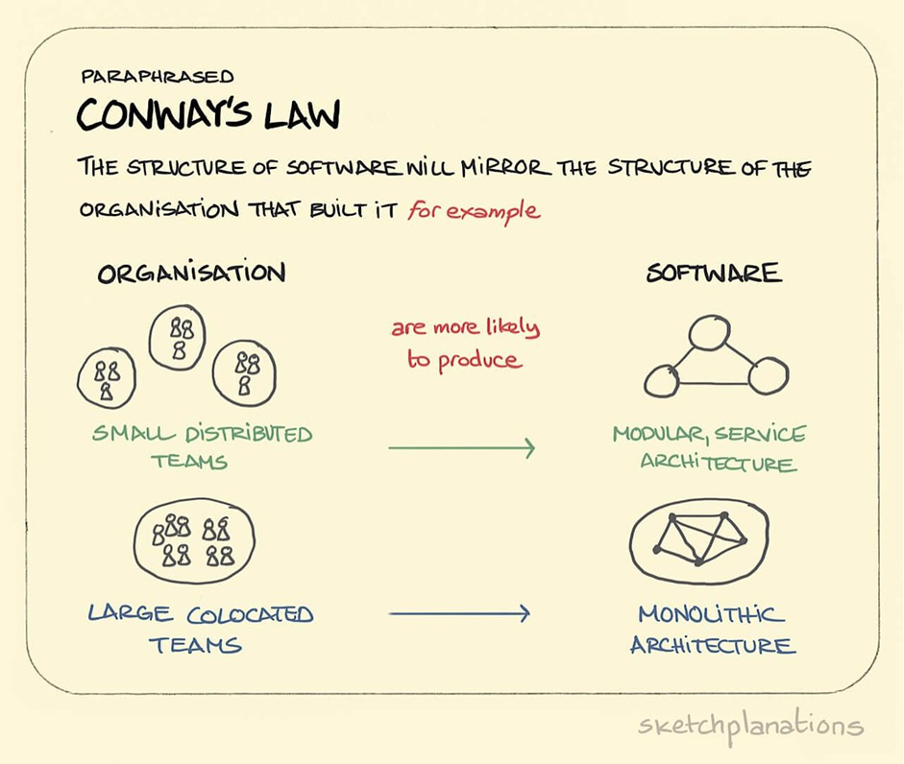
In the rapidly evolving digital landscape, organisations are constantly seeking strategies to improve agility, streamline workflows, and drive faster innovation. One powerful yet often overlooked approach is the Reverse Conway Manoeuvre, a method that aligns organisational structure with ideal software architecture and desired outcomes to drive digital transformation. This concept has gained traction thanks to the work of Matthew Skelton and Manuel Pais in their influential book Team Topologies (1), which provides a clear framework for building software teams that enable effective system design and scalable growth.
In this article, I’ll explore how the Reverse Conway Manoeuvre can impact digital change, supported by real-world examples and look at when we should think twice about using it.
What is the Reverse Conway Manoeuvre?
The Reverse Conway Manoeuvre is based on Conway’s Law, which states, “Any organisation that designs a system will produce a design whose structure is a copy of the organisation’s communication structure.” In other words, the way your teams are structured directly influences your system design.
The Reverse Conway Manoeuvre takes this principle and flips it: by intentionally structuring teams around the desired software architecture and the end-to-end flow of value, rather than traditional functional or siloed departments. The objective is to adjust team structures to better support the desired technical outcomes, rather than simply allowing the existing organisational structure to dictate the software architecture.
As Skelton and Pais emphasise, “Organisational design is a key factor in successful software architecture.” When you actively structure your teams to reflect your software architecture goals, you can eliminate friction points and better support long-term growth.
How does it help Digital Change?
Organisations that leverage the Reverse Conway Manoeuvre often see significant benefits, including faster delivery times, reduced technical debt, and improved collaboration. High-performing organisations prioritise reducing handoffs, delays and dependencies between teams by organising cross-functional teams that have the capability to make decisions and move fast, a principle that is advocated in the book Acclerate (2). Here are some real-world examples:
1. Microsoft Azure: Scaling Cloud Services through Targeted Team Structure
Microsoft faced challenges in scaling its Azure cloud services due to a traditionally siloed team structure. To address this, they reorganised teams to align with specific functions within the Azure platform, such as compute, storage, and networking. By creating cross-functional, self-contained teams focused on individual architectural components, Microsoft allowed each team to innovate autonomously and adapt quickly to market needs. The result was a more modular, scalable system that helped Azure become a leading cloud platform globally.
2. Spotify’s Squad Model: Aligning Teams to Product Features
Spotify famously restructured its teams into “squads,” each dedicated to different parts of its platform—such as playlist curation or user recommendations. These squads are autonomous, with the freedom to develop, test, and release features independently. This team structure closely mirrors Spotify’s desired system architecture, allowing the organisation to rapidly introduce new features and adapt to changing user preferences.
Spotify’s approach exemplifies what Skelton and Pais describe as “team APIs,” where autonomous squads communicate through well-defined interfaces, reducing friction and empowering innovation. “Well-defined team boundaries and interactions,” they note, “help reduce misunderstandings and promote smooth collaboration.” This alignment between team structure and product architecture has allowed Spotify to achieve remarkable speed and adaptability.
Potential Benefits of the Reverse Conway Manoeuvre
- Enhanced Agility, Innovation and Faster Time-to-Market By structuring teams around key system components, the Reverse Conway Manoeuvre enables organisations to reduce interdependencies and increase speed. Autonomous, cross-functional teams can innovate faster, leading to quicker delivery of new features and improvements. Spotify shares three important lessons on maximising the impact of innovation in this article (https://engineering.atspotify.com/2023/08/experimentation-at-spotify-three-lessons-for-maximizing-impact-in-innovation/).
- Reduced Technical Debt and Complexity When team structure aligns with desired system architecture, it minimises the need for workarounds and overlapping responsibilities. This approach can reduce technical debt, leading to simpler, more maintainable systems that are better equipped for future innovation.
- Improved Collaboration and Problem-Solving Cross-functional teams bring together a diverse range of perspectives, from development to UX and operations. With the Reverse Conway Manoeuvre, this alignment creates clear ownership areas, leading to more effective problem-solving and less friction between teams.
When to Think Twice About Applying the Manoeuvre
While the Reverse Conway Manoeuvre offers significant advantages, it’s not without its challenges when applying it.
1. Risk of Increased Coordination Overhead
Cross-functional, autonomous teams require more alignment mechanisms to ensure coherence across different services or products. As Skelton and Pais point out, it’s crucial to implement “clear, lightweight communication pathways” to avoid excessive overhead and coordination challenges.
This was apparent on a recent client engagement, where I was leading the creation of delivery teams to fulfil a large scale, digital transformation. The teams were organised by parts of the value stream, with the aim of mirroring the future system architecture. The team structure allowed more autonomy and less hand off points, but, as ways of working matured, siloed working and duplication of effort began to surface. To prevent this from spreading, cross-team sharing of current work needed to be actively encouraged, with suggested communication channels, cross-team networking and collaboration sessions. This sharing of work in progress does require a certain level of maturity in psychological safety in the workplace, a topic that my colleague Simon Houghton has shone a light on in his recent article, which can be found here.
2. Cultural Resistance to Change
Transitioning from traditional hierarchies to a team structure aligned with system architecture often requires a significant cultural shift. Employees and leaders accustomed to clear reporting lines and top-down directives may resist moving to a model that emphasises autonomy and cross-functional collaboration. Organisations need to invest in change management and build a culture that supports team empowerment for this manoueuvre to succeed.
3. Challenges in Highly Regulated Environments
In highly regulated industries like finance or healthcare, strict compliance requirements often enforce rigid team structures, stifling the flexibility needed for the Reverse Conway Manoeuvre. For instance, a large financial institution may demand oversight on every data processing activity, making it tough to decentralise decision-making.
Empowering teams to make decisions is challenging in organisations accustomed to heavy governance and hierarchy. In a recent client engagement, we found that implementing "guardrails" allowed teams to operate freely within defined boundaries, fostering greater autonomy. At the same time, creating transparent communication channels for senior leadership ensured they had the visibility and trust needed in the decision-making process.
Is It Right For Your Organisation?
While the Reverse Conway Manoeuvre can deliver substantial benefits, it’s not a one-size-fits-all approach. Maybe consider…
- Do You Have Sufficient Digital Maturity? Organisations early in their digital journey may lack the foundational practices needed to support autonomous, cross-functional teams. Digital maturity, as well as familiarity with agile or DevOps practices, is often necessary to make the most of this approach.
- Does Your Culture Support Autonomy? The Reverse Conway Manoeuvre thrives in a culture that values autonomy and accountability. If your organisation is deeply rooted in traditional, hierarchical structures, it may require significant change management efforts to foster the collaborative culture necessary for this approach.
- Are You Prepared to Invest in Communication and Coordination? Autonomous teams still require coordination mechanisms to ensure alignment across the organisation. Companies must invest in clear communication tools and frameworks, such as well-defined team APIs or a dedicated “platform team” to provide shared resources, which Skelton and Pais highlight as key to avoiding duplication and inconsistency.
Ready to apply it?
The Reverse Conway Manoeuvre offers a strategic approach to digital transformation by aligning team structures with the desired outcomes and system architecture and can bring benefits and results. However, implementing the Reverse Conway Manoeuvre requires a deep understanding of your organisation’s culture, digital maturity, and regulatory landscape and significant buy in at every level to support all aspects of the change.
For organisations ready to invest in this approach, the Reverse Conway Manoeuvre can be a powerful framework for change. Whether adopting it in full or using a hybrid model, aligning team structure with software architecture and desired outcomes can make digital transformation both effective and sustainable for the future.
If you would like to discuss how the Reverse Conway Manoeuvre could play a part in your digital transformation, feel free to reach out.

Figure 1: Conway’s Law Paraphrased (https://sketchplanations.com/conways-law (https://sketchplanations.com/conways-law))
 Leadership of Critical Change
Leadership of Critical Change Designing Exceptional Services
Designing Exceptional Services Digital Organisation Optimisation
Digital Organisation Optimisation Driving Engineering Excellence
Driving Engineering Excellence Service Ops Modernisation
Service Ops Modernisation Unlocking the Cloud
Unlocking the Cloud

